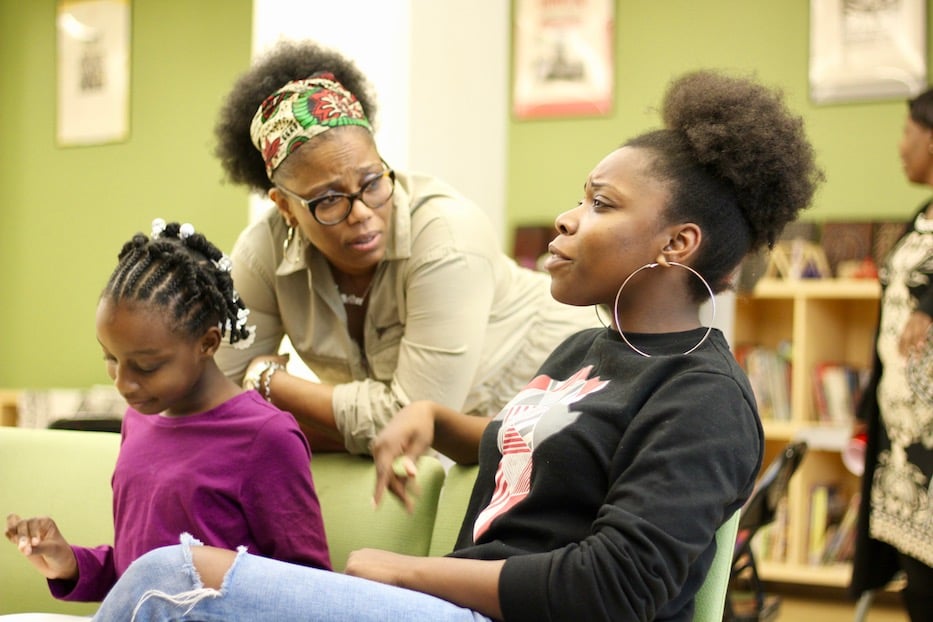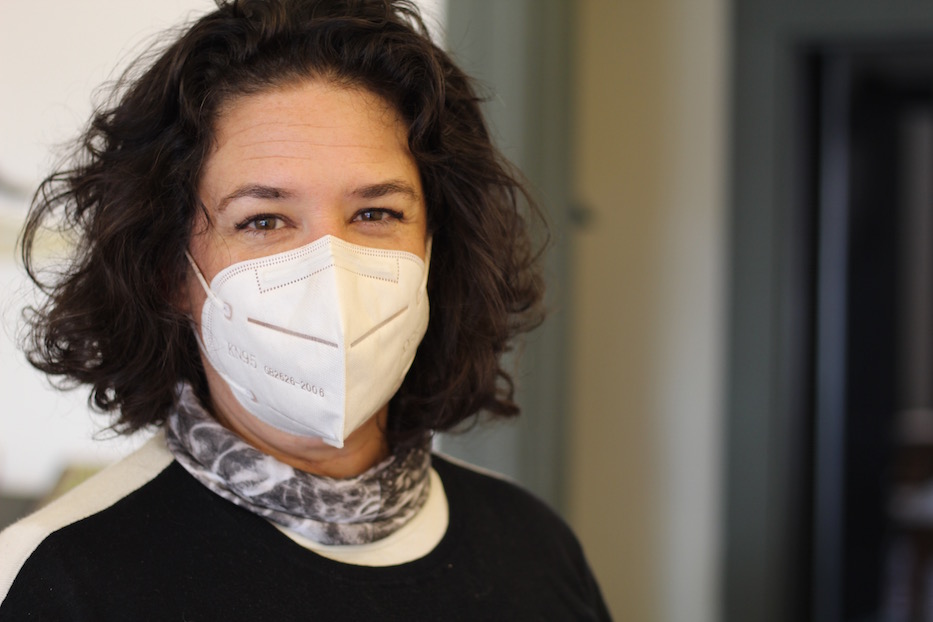
Politics | Arts & Culture | State Legislature | COVID-19
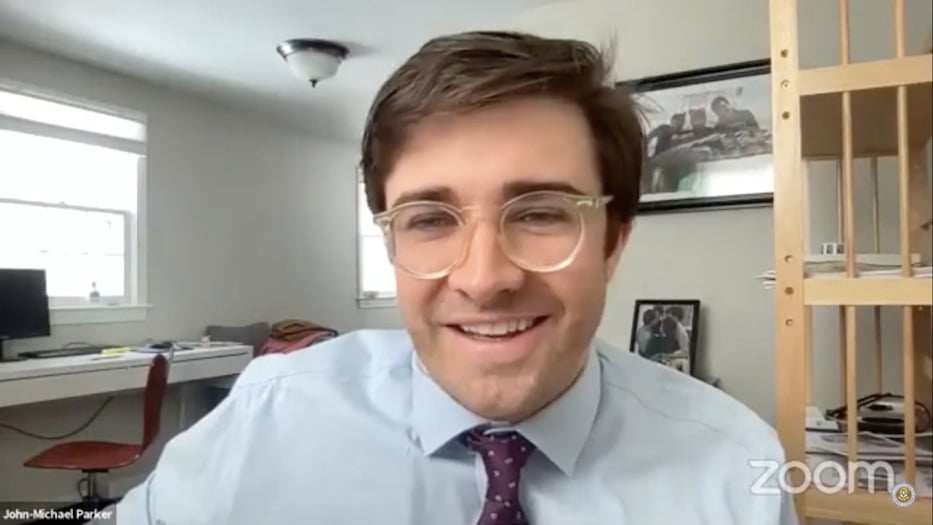
State Rep. John-Michael Parker, who represents Madison and Durham. Screenshot via Zoom.
Constitutional law, anatomy, pre-engineering classes for kids who want to learn dance and jazz music. Student programming that has gone from a red-carpeted auditorium to a virtual stage. New play development that hasn’t stopped during a global pandemic. A vision for the state’s Covid-19 recovery that isn’t complete without its museums, theaters, and orchestras.
Those are a few of the programs that over 100 theater and museum directors, arts administrators, teachers, and individual artists championed Thursday, as they gathered in support of proposed House Bill 6119. Proposed by Madison and Durham State Rep. John-Michael Parker, the bill seeks to raise the percentage of the state’s occupancy tax that goes into the Connecticut Tourism Fund from 10 percent to 25 percent. That extra 15 percent currently goes into the state’s general fund.
In addition, it seeks to codify a current practice of allocating 40 percent of the fund to arts and culture and 60 percent to tourism. Parker said that number would look like an annual increase from $13.1 million to $32.8 million. The increase would support three state agencies: the Connecticut Office of the Arts, Connecticut Humanities, and the Connecticut Office of Tourism. The hearing came in the same week Gov. Ned Lamont announced his biennial budget.
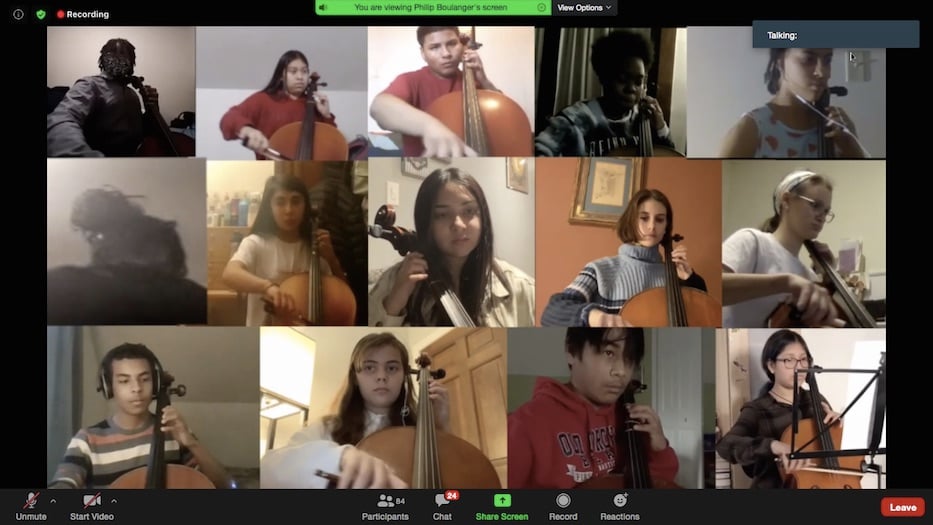
Students at Music Haven, which has received state funding, during their winter performance party last December. Director Mandi Jackson testified in support of the bill. Screenshot from Zoom.
“Such an increase would bring Connecticut on par with our neighboring states in terms of arts, culture, and tourism investment, and would return the industry to the levels of support it received before 2008,” Parker said at the beginning of Thursday’s hearing. “I encourage you to think expansively when you consider the sector. It includes the hotels and restaurants, the museums and performing arts institutions and cultural centers, yes—it also includes educators, and healers, and activists, and community leaders.”
There is overwhelming bipartisan support for the bill, discussions around which have been in the works since 2018. That December, an Arts, Culture & Tourism (ACT) Transition Policy Committee worked with Gov. Ned Lamont to roll out policy suggestions, from a newly-christened Arts, Culture, and Tourism Caucus to the creation of a Cultural Facilities Fund. Since that time, the Connecticut Arts Alliance (CAA) has pushed for more state dollars for the arts.
Prior to Thursday’s hearing, Parker and the CAA worked together to coordinate statewide advocacy efforts, including an overview explaining the bill and how-to for those submitting public testimony. It worked: over 100 arts advocates turned out in support of the bill Thursday, speaking for a total of over six hours. Only a single testimony stands in opposition to the bill at this time.
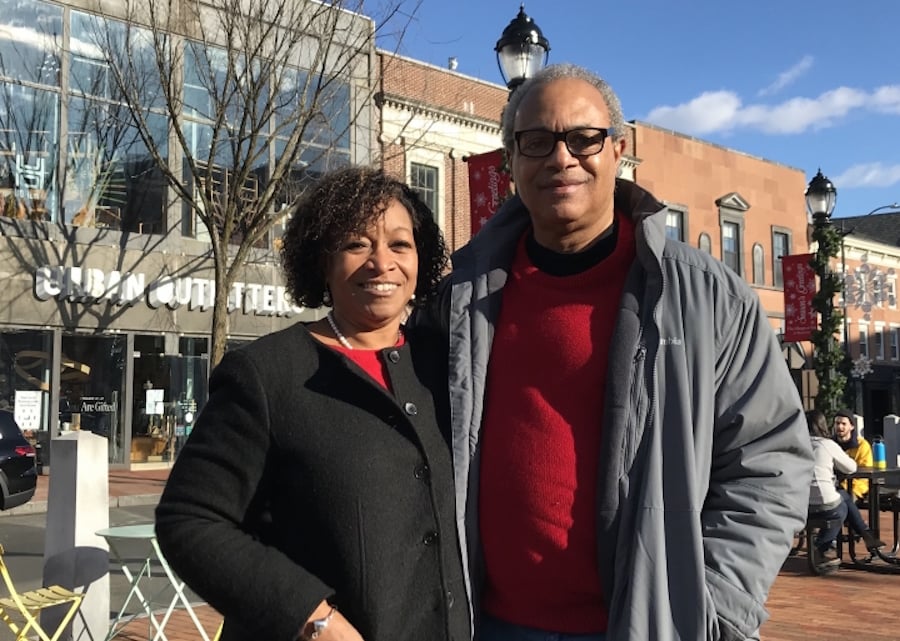
Marcella Monk Flake and Dudley Monk last year. Rabhya Mehrotra for the New Haven Independent File Photo.
Testimonies came from across the state, from educators in its so-called quiet corners to now-struggling theaters in New Haven and Hartford. As founder and director of The Monk Youth Jazz and STEAM Collective, Marcella Monk Flake has watched funding from CT Humanities transform the collective’s programming, from pre-med classes to panel discussions around jazz. More money from the occupancy tax would allow her to grow virtual programming during Covid-19, when New Haven students may most need the extra academic support.
“Arts funding enables us to dream big and provide for these kids,” she said in a phone call Friday morning. “Growing up as a little Black girl in the Hill section of New Haven in a family of nine ... the opportunity to learn to sing, to have access to piano lessons, to be around singers and musicians all of my life created something in me that I wouldn't have if I didn't have the arts.”
Monk Flake said she is excited for new funding possibilities at the intersection of arts and education Before retiring at 58, she taught in the city’s public schools for decades, including 30 years in the district’s gifted education program. Often, she found herself thinking of how many students deserved the same access to academic resources that students on the gifted track received. It was her main motive in launching the collective, which now serves thousands of students in and around New Haven.
She said she would ultimately like to open a physical space akin to CityKids, which taught dance, music, and theater on Ella T. Grasso Boulevard for years before it closed. When she’s thinking about how to get to that goal, every dollar from the state counts.
“It would enable us to expand the educational and arts opportunities for area youth,” she said. “I've seen the arts transform people.”
Asia Murphy, Deidre Johnson and Kendall Driffin in Her Time. Lucy Gellman Pre-Pandemic File Photo.
Hangtime and Her Time Founder Charles Grady also focused on arts funding as a vital tool for education. Prior to Covid-19, state funding allowed Grady and playwright Steve Driffin to write and premiere Her Time at the Klein Memorial Auditorium in Bridgeport. In the play, a character must navigate present-day New Haven as a felony record follows her everywhere.
After the play premiered, state funds also covered a talkback between Dr. Maysa Akbar, who has written several books on trauma, and several Connecticut residents who have dealt with the carceral state themselves. As he continues to lead anti-violence efforts during the pandemic, Grady called the arts integral to healing and recovery.
“All this was made possible by the use of grant funding!” he wrote an impassioned testimony. “CT has a rich history for entertainment thus I encourage and will help push for this legislation as an absolute need. Increase the funds!!!”
Leslie Elias-Saed, an arts teacher and artistic director at Grumbling Gryphons Traveling Children’s Theatre, suggested that more state funding for the arts would translate directly to more educational opportunities for kids across the state. In the past 41 years, Grumbling Gryphons has performed in schools, museums, and theaters for Connecticut residents of all ages.
After the beginning of Covid-19, a grant from the Connecticut Office of the Arts allowed it to launch virtual programming options for schools. Elias-Saed said she hopes to build on that work as the pandemic continues.
“We have employed countless mask makers, artists, musicians, composers, started and launched careers for young actors, people of all ages, people of all races, religions,” she said. “Our work is innovative and we work interactively in the schools. It’s been a tough year.”
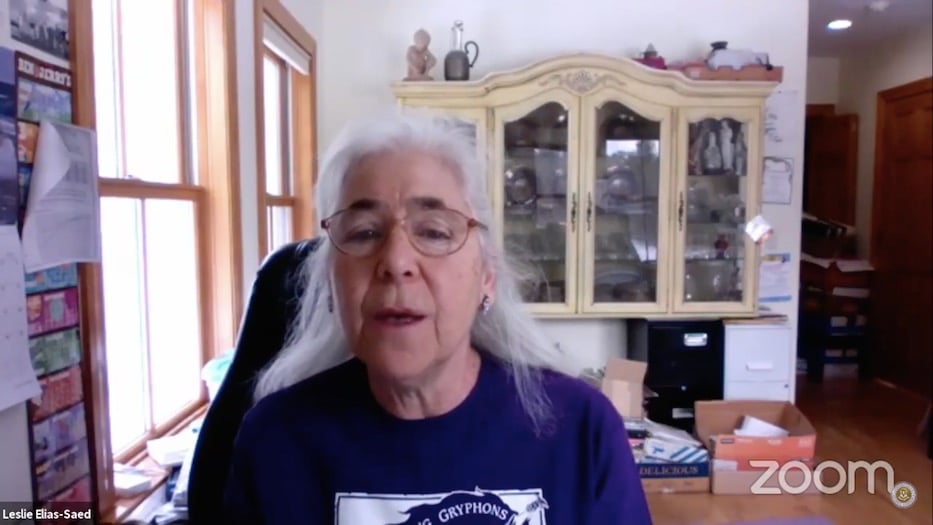
Several who spoke also pointed to the arts as an economic driver. Prior to COVID-19, the state’s arts, culture and tourism sector generated $9 billion, 57,000 jobs, and five percent of Connecticut’s economy. Now, the sector has been gutted by the pandemic, and several arts organizations are hanging on by a thread.
In a joint letter from Connecticut Flagship Producing Theatres (CFPT), representatives of Goodspeed Musicals, Hartford Stage, Long Wharf Theatre, the Eugene O’Neill Theatre Center, Westport Country Playhouse and Yale Repertory Theatre noted that before the pandemic, the six theaters alone brought in $42 million per year, a number that includes the creation of 1,488 jobs and $12.4 million spent locally.
With the exception of the Yale Repertory Theatre, all of them have issued multiple rounds of layoffs and furloughs since March 2020 (read more about that here and here). The Yale Repertory Theatre is also the only theater in Connecticut attached to an institution with a $30 billion endowment. It has still reported losses of 60 guest artists and $592,400.
“Beyond our economic impact we also have an essential community impact,” they wrote. “Each of our organizations has partnerships with schools and local organizations, offering a vast array of programs ranging from student matinees to library discussions on inclusivity to training teachers and young theatre professionals. Collectively, we serve over 40,000 students of all ages throughout the state.”
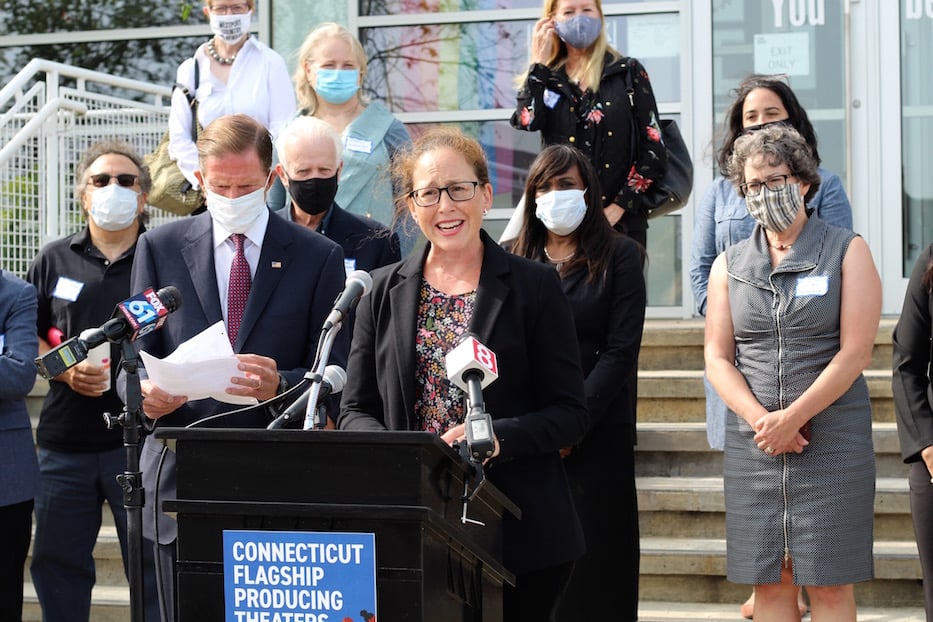
Ingui at a press conference for federal funding in September 2020. Lucy Gellman File Photo.
Kit Ingui, managing director at Long Wharf Theatre, urged legislators to support and pass the bill as arts organizations struggle to stay afloat. In the past year, Long Wharf has eliminated 40 full- and part-time positions, bringing a staff of 65 to 25. With that skeleton crew, it has continued to roll out virtual programming, from Zoom-based script readings and new play development to fully produced online performances.
“We are bridge‐ builders, linking communities through the power of storytelling in all its forms. We are soul‐healers, providing space for joy, connection, and reconciliation even during this time of isolation,” she wrote Thursday. “We are change‐makers, using our art to progress conversations around racial inequity, income disparity, environmental sustainability, and the myriad challenges faced by our communities. We are voices that encourage our communities to hear, see, and address these challenges. “
While the bulk of testimonies came from arts institutions large and small, individual artists also weighed in with their unequivocal support. Multimedia artist and curator Martha Willette Lewis focused on the role the arts have played in helping people cope with the isolation, fear, and anxiety of a global pandemic. In New Haven’s East Rock neighborhood, Lewis has used the past 11 months to start a nightly Quarantine Cinegram series from her kitchen window. She praised the Connecticut Office of the Arts for its ongoing support, and noted the importance of supporting individual artists and makers in addition to the museums, theaters, and symphonies that often receive the bulk of state funding.
“During the pandemic what have people been doing to stay safe, healthy and happy?” she asked in her testimony. “Consume art, that is what. Endlessly, along with exploring nature and exercising outdoors. Just look at social media -- look at people’s posts, ask them. Watching dramas on Netflix, following cooking tutorials on YouTube, crafting, enjoying virtual events, exhibits, concerts, taking remote yoga and dancing lessons, hair-braiding, journaling, listening to the radio. It is all art, and someone had to create the content, the instructions, kits, Zoom events.”
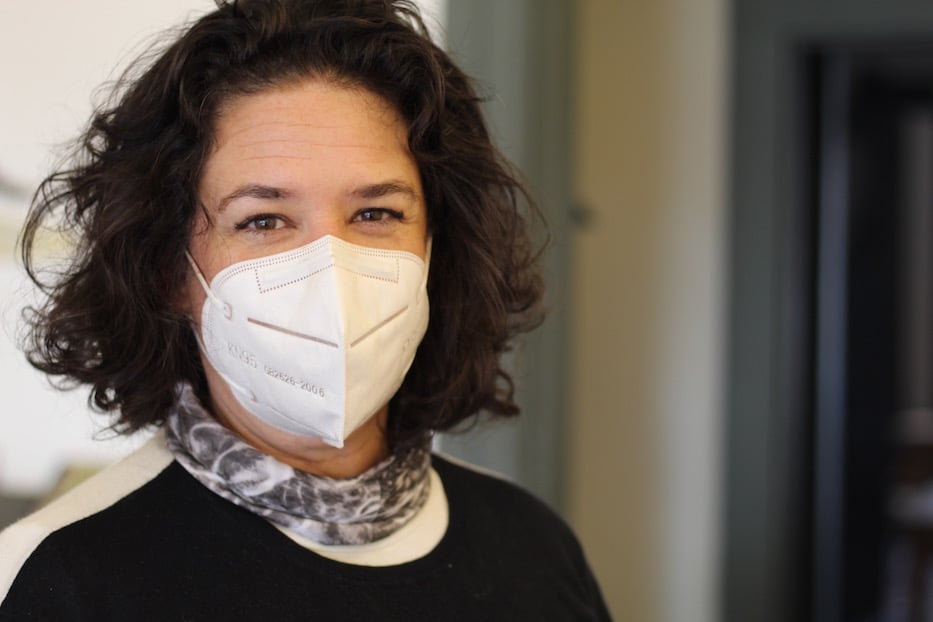
Martha Willette Lewis at the Institute Library, where she is a curator, in October 2020. Lucy Gellman File Photo.
Legislators have remained mum on a potential equity component of the bill, which would earmark a percentage of funds specifically for youth and artists of color and programs in historically under-resourced and underfunded neighborhoods. Mandi Jackson, executive director at Music Haven, urged legislators to consider the importance of both expanded and equitable access to arts funding.
“This is inherently a shrinking sector if it is a sector that speaks and responds only or primarily to predominantly white communities of affluence,” she said. “And only expanded public support for our sector can support programs like ours, which focus on inclusion and equity.”


